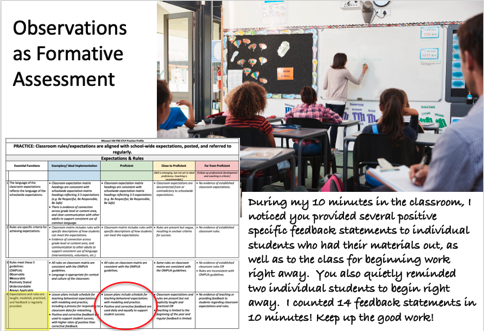Teaching and modeling, opportunities to practice, and feedback are effective instructional strategies for all learners, including adults. Below is a synopsis of potential systems to support teacher implementation of ETLPs, for a more thorough discussion of such systems see the Professional Learning Module.
According to Simonsen and colleguages (2014) professional learning that is sustainable for individual teachers or teams of teachers must include:
- High Quality Professional Development
- Opportunities to Practice
- Walkthroughs and Feedback
Providing High Quality Professional Development
When teachers have access to professional development they find relevant to their needs, they are more likely to engage in the process.Once the prioritized ETLPs and essential functions have been established, teachers will need training and resources. Districts should use data from teacher Self-Assessments and Practices Profiles to plan and schedule formal professional development, which might include small group or individual professional development, classes, online resources, learning from peers, and/or many other options.
Supporting the Use of ETLPs In Practice
Opportunities to Practice
After teachers have had the opportunity to participate in professional development, they will need to practice using the ETLP in their classrooms. It is helpful to target a small period of time during the day for practice and data collection. For example, a teacher might choose to target monitoring their delivery of feedback in the hallway because it is a time of day when students need some additional practice and feedback with expectations.
Consider how a teacher can demonstrate proficiency for Expectations and Rules, Essential Function 4, with the proficiency criteria of:
- I explicitly teach my students the expectations and rules at the beginning of the year.
- I almost always provide feedback to my students on meeting the expectations and rules.
- I have a schedule for teaching behavioral expectations across the year.
- I create lesson plans for teaching behavioral expectations.
- I use positive feedback more often than I use negative feedback.
- I use behavioral data to determine when reteaching of expectations is needed.
The teacher would include in the lesson plans for that subject/time of day the ETLP of Expectations and Rules and their strategy for teaching, modeling, practicing, and providing feedback around that practice. If the classroom expectation is for students to demonstrate responsibility by bringing all materials to class and getting started right away with bell work, the teacher would teach/re-teach the expectation, model what materials should be present, what to do if something is needed, and what getting started “right away” looks like. The teacher should be clear with students as they practice the expectation, providing feedback, and finally, make a plan for targeting Responsibility with additional feedback (and possibly tickets/tokens, etc.) for a specified period of time – starting with just one period a day.
As the teacher delivers the lesson plan, the students, other teachers, the coach or an administrator could collect data (frequency, rate, and/or ratio of feedback) and provide feedback to the teacher. The teacher could use this data to monitor their progress toward the goal. For example, a goal might be to make at least 2 positive feedback statements per minute during the targeted time of day. Setting specified criteria will provide information regarding improvements in implementation.
There are information and resources for a peer observation protocol in the MO SW-PBS Tier 1 Workbook, or online at http://pbismissouri.org
Walk Throughs and Feedback
As part of the feedback process, administrators or coaches can use walkthroughs and informal observation to provide feedback to the teacher as well. This should be viewed as a support rather than an evaluation. Using the practice profile to leave specific feedback gives the teacher data they can use to improve their implementaiton efforts. It also values and communicates that the observer is aware of the teacher’s focus on an ETLP.

In this example, the observer noted that much of the feedback was provided to individuals. This teacher may choose to increase feedback to the group, or continue to mainly provide individual feedback, with additional focus on opportunities to provide positive specific feedback to the students who may be receiving more corrective feedback than others.

